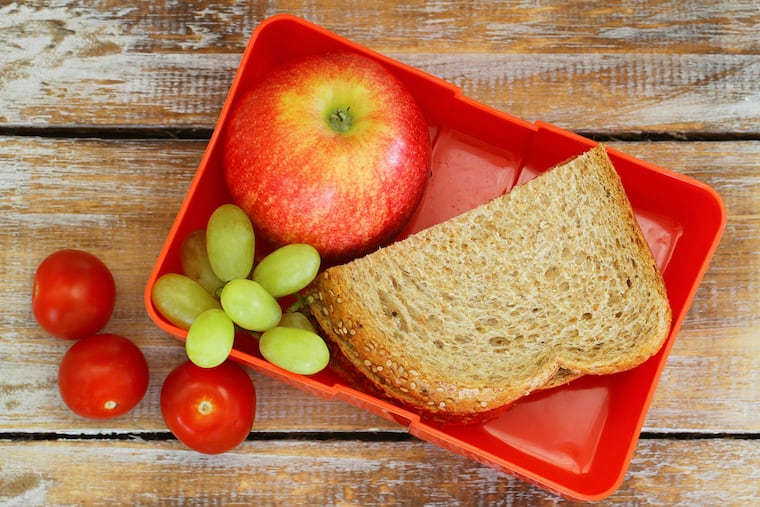Are we serving up healthy school lunches?
A Philadelphia nutritionist takes a closer look at lunch standards at our schools.

School lunch is supposed to be a time for students to take a break from class, socialize with their friends, and eat a nourishing meal. The Healthy Hunger-Free Kids Act was established in 2010 with a goal to improve school lunch and breakfast programs.
Each year it serves over 30 million students school lunches that meet specific nutrition guidelines mandated by the U.S. Department of Agriculture to help reduce obesity and other health risks. These were the first major changes in school meals in 15 years made by the USDA. Even though we may be serving healthier lunches, are they actually meeting nutritional recommendations and are kids eating them? Let's take a closer look.
National school lunch requirements
Each lunch meal should meet the following nutritional guidelines:
At least a half cup of fruits and vegetables, including weekly portions of legumes, dark green, and red or orange vegetables
Whole-grain rich starches
Calorie limits based on grades:
- Grades K-5: 550-650 calories
- Grade 6-8: 600-700 calories
- Grade 9-12: 750-850 calories
One cup of fat-free unflavored or flavored milk and/or low-fat unflavored only
Sodium limits based on grade as of July 1, 2017
- Grades K-5: <935 mg sodium
- Grade 6-8: <1,035 mg sodium
- Grade 9-12:<1,080 mg sodium
Meat/meat alternative not including tofu, beans or legumes
No added trans-fats and no more than 10% of calories from saturated fat
What's for lunch?
A typical lunch meal served at a public school for grades K-8 may include:
Hot dog on a whole grain bun, celery with ranch dressing, and potato rounds, and a choice of either fat free chocolate milk or 1 percent white milk- OR
Chef salad with chicken with light Italian dressing, banana, whole grain tortilla rounds and a choice of either fat free chocolate milk or 1 percent white milk
Nutrition Goals for School Lunches
Each lunch meal is calorically based for each age group and meets the Dietary Guidelines for Americans (DGA) for total fat, saturated fat and dietary fiber, according to the USDA. However, current food service systems are strained due to the financial burdens of maintaining strict nutrition requirements, fewer students choosing school lunch, and increased food waste due to the lack of time to finish a meal.
Changes to the current lunch program have recently been proposed that would loosen the standards for providing whole-grain foods and sodium restrictions. While the changes might make meals more palatable and pleasing to students, they would also compromise sodium and dietary fiber standards.
And why don't we see anything related to sugar? When you look at most school menus, the amount of added sugars are not listed in the nutrition facts, only the amount of total carbohydrate. The new nutrition standards do not limit the amount in school meals. Even though sugar-containing soft drinks were eliminated from schools, added sugars are found in processed grains, canned fruits, fruit juice, and flavored milk. According to the American Heart Association, kids, ages 2 to 18, should reduce added sugars daily to less than 25 grams (6 teaspoons) for a healthy heart, but is this realistic?
The DGA Advisory Committee cautions over restricting added sugars to avoid compromising students' overall nutrition. For example, it has been found that overall milk consumption declines when banning flavored milk in schools, which not only reduces added sugars and calories, but it also reduces students' intake of calcium and protein.
Added sugars found in soft drinks, candy and cookies do not provide any nutritional value and are considered "empty calories"; however, added sugars found in flavored milk and whole-grains are nutrient-dense and essential for students' growth and energy.
How to improve school lunches
This battle of providing tasty, healthy meals to students while staying within the budget continues to be controversial. The Healthy Hunger-Free Act has only been in effect since 2010, and we cannot expect schools and students to adapt to a new way of eating overnight. This may be a big task, but small steps are being made to improve the taste and nutrition for our students while staying within a budget.
Studies have shown that repeated exposure is key to improve kids' intake of new or unfamiliar foods. Schools need to develop healthier recipes that kids will enjoy, provide taste tests at lunch to increase exposure to fruits and vegetables, and give students more time to eat their meal and to adjust to healthier menus.
Similarly, at home, parents can encourage kids to eat a variety of fruits and vegetables by introducing them in meals, snacks, and including them when packing lunch for school. You may be surprised what kids will eat sometimes!